
Scorpions are predatory arachnids of the order Scorpiones. They have eight legs and are easily recognized by a pair of grasping pincers and a narrow, segmented tail, often carried in a characteristic forward curve over the back and always ending with a stinger. The evolutionary history of scorpions goes back 435 million years. They mainly live in deserts but have adapted to a wide range of environmental conditions, and can be found on all continents except Antarctica. There are over 2,500 described species, with 22 extant (living) families recognized to date. Their taxonomy is being revised to account for 21st-century genomic studies.

Serket is the goddess of healing venomous stings and bites in Egyptian mythology, originally the deification of the scorpion. Her family life is unknown, but she is sometimes credited as the daughter of Neith and Khnum, making her a sister to Sobek and Apep.
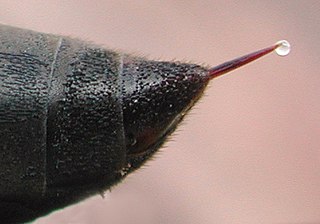
A stinger is a sharp organ found in various animals capable of injecting venom, usually by piercing the epidermis of another animal.
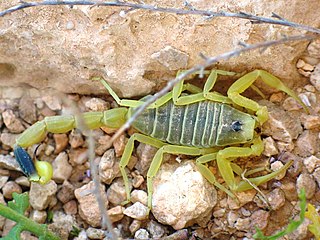
The deathstalker is a species of scorpion, a member of the family Buthidae. It is also known as the Palestine yellow scorpion, Omdurman scorpion, and Naqab desert scorpion, as well as by many other colloquial names, which generally originate from the commercial captive trade of the animal. To eliminate confusion, especially important with potentially dangerous species, the scientific name is normally used to refer to them. The name Leiurus quinquestriatus roughly translates into English as "five-striped smooth-tail". In 2014, the subspecies L. q. hebraeus was separated from it and elevated to its own species Leiurus hebraeus. Other species of the genus Leiurus are also often referred to as "deathstalkers". Leiurus quinquestriatus is yellow, and 30–77 millimetres (1.2–3.0 in) long, with an average of 58 mm (2.3 in).

The Arizona bark scorpion is a small light brown scorpion common to the Sonoran Desert in the southwestern United States and northwestern Mexico. An adult male can reach 8 cm in length (3.14 inches), while a female is slightly smaller, with a maximum length of 7 cm (2.75 inches).
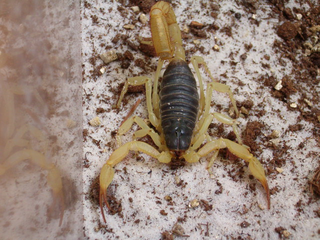
Hadrurus spadix is a large scorpion native to the southern deserts of North America. It is a burrowing scorpion which spends a lot of time digging in the sand and enlarging its burrow. A similar species is the giant desert hairy scorpion.

Hadrurus arizonensis, the giant desert hairy scorpion, giant hairy scorpion, or Arizona Desert hairy scorpion is a large scorpion found in North America.

Dendrocnide moroides, commonly known in Australia as the stinging tree, stinging bush, or gympie-gympie, is a plant in the nettle family Urticaceae found in rainforest areas of Malesia and Australia. It is notorious for its extremely painful and long-lasting sting. The common name gympie-gympie comes from the language of the indigenous Gubbi Gubbi people of south-eastern Queensland.
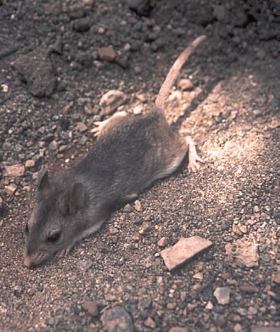
The southern grasshopper mouse or scorpion mouse is a species of predatory rodent in the family Cricetidae, native to Mexico and the states of Arizona, California, Nevada, New Mexico, and Utah in the United States. Notable for its resistance to venom, it routinely preys on the highly venomous Arizona bark scorpion.
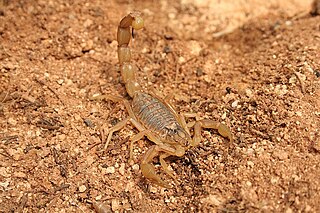
Buthus occitanus, the common yellow scorpion, is a species of scorpion in the family Buthidae. It occurs in the Middle East, North Africa and Europe.

A scorpion sting is an injury caused by the stinger of a scorpion resulting in the medical condition known as scorpionism, which may vary in severity. The anatomical part of the scorpion that delivers the sting is called a "telson". In typical cases, scorpion stings usually result in pain, paresthesia, and variable swelling. In serious cases, scorpion stings may involve the envenomation of humans by toxic scorpions, which may result in extreme pain, serious illness, or even death depending on the toxicity of the venom.

Hottentotta tamulus, the Indian red scorpion, also known as the eastern Indian scorpion, is a species of scorpion of the family Buthidae. It occurs in most of India, eastern Pakistan and the eastern lowlands of Nepal, and recently from Sri Lanka.
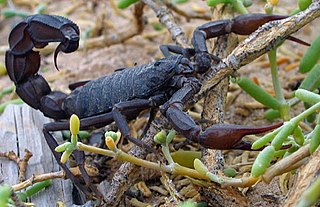
Androctonus crassicauda, the Arabian fat-tailed scorpion, is a species of extremely dangerous scorpion usually found in North Africa and the Middle East.

Androctonus bicolor, the black fat-tailed scorpion, is a scorpion species of the family Buthidae. It is black in color and can grow up to 8 cm. Black fat-tailed scorpions come from the family Buthidae, which is the largest of the scorpion family. They can be identified by their hefty physique. They tend to move very fast, and are of an aggressive nature. Black fat–tailed scorpions can live for up to 5 years. Adults can reach up to 40-60 millimeters, 80 millimeters being the maximum. These scorpions typically possess black and brown coloration. These scorpions enjoy making scrapes with wood and rocks, and are nocturnal, thus they hide in crevices or certain objects during the day. They stay in shade to retain moisture in their bodies, as they are susceptible to losing moisture due to their environmental preference.

Centruroides gracilis is a species of scorpion in the family Buthidae, the bark scorpions. Its common names include Florida bark scorpion, brown bark scorpion, and slender brown scorpion. In Cuba it is known as alacran prieto and alacran azul. Contrary to one of its common names, it is not actually native to Florida in the United States. It is native to northern parts of the middle Americas, including Mexico, Guatemala, Belize, and Honduras. It is present in other parts as an introduced species, including Cuba, Panama, Colombia, Ecuador, Jamaica, and Florida in the United States. It is also introduced in parts of Africa, including Cameroon and Gabon, as well as the island of Tenerife

Hadrurus is a genus of scorpions which belongs to the family Hadruridae. They are found in sandy deserts and other xeric habitats in northwestern Mexico and in southwest United States. They are among the largest of all scorpion genera, only surpassed by Hadogenes, Pandinus, Heterometrus and Hoffmannihadrurus.

Leiurus abdullahbayrami is a species of scorpion in the family Buthidae. Its venom is highly toxic to humans, but can be used in medical development.

Eryngium creticum, or the field eryngo, is a species of flowering plant in the family Apiaceae native to Greece, Israel, Jordan, Lebanon, Palestine, and Syria. It is known in Lebanon and Palestine as قرصعنة and in Israel as חרחבינה מכחילה.

Hemiscorpius lepturus is a species of scorpion in the family Hemiscorpiidae. It is found in deserts of the Middle East, especially in southern Iraq and Iran, where it is sometimes referred to as the "Gadim scorpion". These scorpions have long, thin tails and wide bodies and grow to 8 cm (3.1 in) in males and 5.5 cm (2.2 in) in females, allowing them to live in tight rock crevices. They are fairly solitary creatures. H. lepturus has mainly been studied to discover the components and effects of its venom, which is highly lethal and is responsible for most deaths due to scorpion sting in the Iran area. H. lepturus is the only scorpion not in the family Buthidae that is potentially lethal to humans; the Buthidae family is the largest and most abundant family of scorpions, containing many highly venomous species.

















